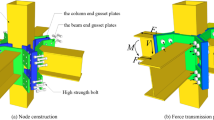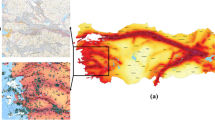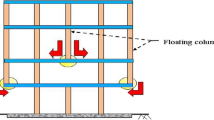Abstract
The frame beam anchor plate (FBAP) reinforced slope has been popularized and applied in some fill slope projects. Nevertheless, the existing design method ignores the influence of earthquake action and the suction effect of unsaturated soils. The stability of unsaturated soil slopes reinforced with FBAPs under an earthquake is analyzed based on the upper bound theorem of limit analysis and pseudo-dynamic method to solve the above problems. The influence of the suction effect on the effective weight and strength of unsaturated soils under one-dimensional steady seepage conditions was considered in the derivation of the energy balance equation. A simplified method based on the volume integral of the rotating body is used to calculate the external work rate. Two possible failure modes of anchorage structures are considered when solving internal energy dissipation. Results show that the influence of suction and seepage conditions on slope stability decreases with the increasing soil pore size distribution parameter n and saturated hydraulic conductivity ks. Also, the stability of the slopes is significantly improved with the increase of total rows of anchor plates. Likewise, the stability of slopes decreases with the increase in the horizontal seismic coefficient kh and amplification coefficient fa.
Similar content being viewed by others
Abbreviations
- 1, 2, …, i, …, m :
-
Serial numbers of anchor plates
- c :
-
Total cohesion
- c′ :
-
Effective cohesion
- c″ :
-
Capillary cohesion −σstanφ′
- D :
-
Internal energy dissipation
- D c′ :
-
Energy dissipation rate caused by effective cohesion
- D c″ :
-
Energy dissipation rate caused by capillary cohesion
- D T :
-
Energy dissipation rate caused by anchor plates
- f a :
-
Acceleration amplification factor
- F i :
-
Shear resistance
- F S :
-
Safety factor
- f y, A s :
-
Yield strength and cross-sectional area of tie rod
- G s :
-
Soil-specific gravity
- H :
-
Slope height
- h i :
-
Burial depth
- K 0 :
-
Coefficient of earth pressure at rest
- K a :
-
Coefficient of active earth pressure
- k h :
-
Horizontal seismic coefficien
- k h(z, t):
-
Pseudo-dynamic horizontal seismic coefficient
- k s :
-
Saturated hydraulic conductivity
- K p :
-
Coefficient of passive earth pressure
- L :
-
Length of line segment AB in Fig. 3
- L a, L b, L h :
-
Length, width and thickness of anchor plate
- n :
-
Soil pore size distribution parameter
- P i :
-
Resistance generated at the front end of the anchor plate
- Q :
-
Uniformly distributed load at the top of a slope
- q :
-
Steady flow rate
- r, r 0 :
-
Polar diameters corresponding to angles θ and θ0
- R int :
-
Strength reduction coefficient
- r Ti, θ Ti :
-
Polar diameter and rotation angle corresponding to anchor plate
- S :
-
Pore-water degree of saturation
- S e :
-
Effective degree of saturation
- S r :
-
Residual degree of saturation
- t :
-
Time
- T 0 :
-
Seismic period
- T i :
-
Anchoring force
- T pi :
-
Ultimate pullout resistance of anchor plate
- T s :
-
Ultimate pullout resistance of tie rod
- u a :
-
Pore-air pressure
- u a − u w :
-
Matrix suction
- u w :
-
Pore-water pressure
- W :
-
External work rate
- W s :
-
External work rate caused by seismic force
- W Q :
-
External work rate caused by slope top overload
- W γ′ :
-
External work rate caused by soil weight
- z :
-
Vertical distance from a point in the slope body to the toe
- z 0 :
-
Vertical distance from the toe to the water table
- α :
-
Inverse of the air entry pressure
- β :
-
Slope inclination angle
- θ :
-
Rotation angle of failure mechanism
- θ B :
-
Rotation angle corresponding to the point B
- θ 0, θ h :
-
Minimum and maximum rotation angle of failure mechanism
- γ′ :
-
Effective unit weight of unsaturated soils
- γ s :
-
Unit weight of saturated soil
- γ w :
-
Unit weight of water
- φ′ :
-
Effective internal friction angle
- ν s :
-
Shear wave velocity
- σ :
-
Total stress
- σ′ :
-
Effective stress
- σ s :
-
Suction stress
- ξ :
-
Lateral pressure coefficient
- τ f :
-
Shear strength of unsaturated soil
- τ fi :
-
Interface shear strength
- ω :
-
Angular velocity
References
Alhajj Chehade H, Guo X, Dias D, Sadek M, Jenck O, Hage Chehade F (2022) Reliability analysis for internal seismic stability of geosynthetic-reinforced soil walls. Geosynthetics International, DOI: https://doi.org/10.1680/jgein.22.00250
Bishop AW (1959) The principle of effective stress. Teknisk Ukeblad I Samarbeide Med Teknikk, Oslo
Cavalcante ALB, Mascarenhas PVS (2021) Efficient approach in modeling the shear strength of unsaturated soil using soil water retention curve. Acta Geotechnica 16:3177–3186, DOI: https://doi.org/10.1007/s11440-021-01144-6
Chen WF (1975) Limit analysis and soil plasticity. Elsevier, Amsterdam
Cheng YM, Lansivaara T, Wei WB (2007) Two-dimensional slope stability analysis by limit equilibrium and strength reduction methods. Computers and Geotechnics 34:137–150, DOI: https://doi.org/10.1016/j.compgeo.2006.10.01
China Ministry of Urban & Rural Construction (2011) Code for design of building foundation: GB 5007-2011. China Building Industry Press, Beijing
China Ministry of Urban & Rural Construction (2012) Technical specification for underreamed anchor by jet grouting: JGJ/T 282-2012. China Building Industry Press, Beijing
Cho SE (2016) Stability analysis of unsaturated soil slopes considering water-air flow caused by rainfall infiltration. Engineering Geology 211:184–197, DOI: https://doi.org/10.1016/j.enggeo.2016.07.008
Fang GW, Zhu YP, Ye SH, Huang AP (2022) Analysis of force and displacement of anchor systems under the non-limit active state. Scientific Reports 12:1306, DOI: https://doi.org/10.1038/s41598-021-04668-9
Fathipour H, Payan M, Chenari RJ (2021) Limit analysis of lateral earth pressure on geosynthetic-reinforced retaining structures using finite element and second-order cone programming. Computers and Geotechnics 134:104119, DOI: https://doi.org/10.1016/j.compgeo.2021.104119
Gardner WR (1958) Some steady-state solutions of the unsaturated moisture flow equation with application to evaporation from a water table. Soil Science 85(4):228–32, DOI: https://doi.org/10.1097/00010694-195804000-00006
He SM, Ouyang CJ, Luo Y (2012) Seismic stability analysis of soil nail reinforced slope using kinematic approach of limit analysis. Environmental Earth Sciences 66:319–326, DOI: https://doi.org/10.1007/s12665-011-1241-3
Huang AP, Zhu YP, Wang Long, Ye SH, Fang GW (2023) Three-dimensional stability of unsaturated soil slopes reinforced by frame beam anchor plates. International Journal of Geomechanics 23(6): 04023068, DOI: https://doi.org/10.1061/IJGNAI.GMENG-8173
Kontoe St, Pelecanos L, Potts D (2013) An important pitfall of pseudostatic finite element analysis. Computers and Geotechnics 48:41–50, DOI: https://doi.org/10.1016/j.compgeo.2012.09.003
Li XP, He SM, Wu Y (2011) Limit analysis of the stability of slopes reinforced with anchors. International Journal for Numerical and Analytical Methods in Geomechanics 36(17):1898–1908, DOI: https://doi.org/10.1002/nag.1093
Li AJ, Merifield RS, Lyamin AV (2010) Three-dimensional stability charts for slopes based on limit analysis methods. Canadian Geotechnical Journal 47:1316–1334, DOI: https://doi.org/10.1139/T10-030
Li LC, Tang CA, Zhu WC, Liang ZZ (2009) Numerical analysis of slope stability based on the gravity increase method. Computers and Geotechnics 36:1246–1258, DOI: https://doi.org/10.1016/j.compgeo.2009.06.004
Li ZY, Xiao SG (2023) Seismic overall stability of embankment slopes retained by multi-step cantilever retaining walls using pseudo-static method. Geotechnical and Geological Engineering 41:1893–1907, DOI: https://doi.org/10.1007/s10706-023-02378-9
Lu N, Godt JW (2013) Hillslope hydrology and stability. Cambridge University Press, New York
Lu N, Likos WJ (2004) Unsaturated soil mechanics. John Wiley & Sons, New York
Ruan XB, Luo YS, Yan J, Zhang L (2021) Seismic internal stability of bilinear geosynthetic-reinforced slopes with cohesive backfills. Soil Dynamics and Earthquake Engineering 143:106599, DOI: https://doi.org/10.1016/j.soildyn.2021.106599
Santhoshkumar G, Ghosh P (2021) Closed-form solution for seismic earth pressure on bilinear retaining wall using method of characteristics. Journal of Earthquake Engineering 25(6):1171–1190, DOI: https://doi.org/10.1080/13632469.2019.1570880
Shao GX, Sun TZ, Li T, Xu P (2023) Seismic stability analysis of slopes using a pseudo-dynamic method combined with an upper bound method. Soil Mechanics and Foundation Engineering 60(1):79–85, DOI: https://doi.org/10.1007/s11204-023-09866-3
Shi KY, Wu XP, Liu Z, Dai SL (2019) Coupled calculation model for anchoring force loss in a slope reinforced by a frame beam and anchor cables. Engineering Geology 260:105245, DOI: https://doi.org/10.1016/j.enggeo.2019.105245
Sun DA, Wang L, Li L (2019) Stability of unsaturated soil slopes with cracks under steady-infiltration conditions. International Journal of Geomechanics 19(6):04019044, DOI: https://doi.org/10.1061/(ASCE)GM.1943-5622.0001398
Tan MX, Vanapalli SK (2022) Foundation bearing capacity estimation on unsaturated soil slope under transient flow condition using slip line method. Computers and Geotechnics 148:104804, DOI: https://doi.org/10.1016/j.compgeo.2022.104804
Vahedifard F, Leshchinsky D, Mortezaei K, Lu N (2016) Effective stress-based limit-equilibrium analysis for homogeneous unsaturated slopes. International Journal of Geomechanics 16(6):04016003, DOI: https://doi.org/10.1061/(ASCE)GM.1943-5622.0000554
van Genuchten MT (1980) A closed-form equation for predicting the hydraulic conductivity of unsaturated soilss. Soil Science Society of America Journal 44(5):892–898, DOI: https://doi.org/10.2136/sssaj1980.03615995004400050002x
Villalobos SA, Villalobos FA (2021) Effect of nail spacing on the global stability of soil nailed walls using limit equilibrium and finite element methods. Transportation Geotechnics 26:100454, DOI: https://doi.org/10.1016/j.trgeo.2020.100454
Wang L, Sun DA, Yao YP, Wu LZ, Xu YF (2020) Kinematic limit analysis of three-dimensional unsaturated soil slopes reinforced with a row of piles. Computers and Geotechnics 120:10342, DOI: https://doi.org/10.1016/j.compgeo.2019.103428
Wei WB, Cheng YM, Li L (2009) Three-dimensional slope failure analysis by the strength reduction and limit equilibrium methods. Computers and Geotechnics 36:70–80, DOI: https://doi.org/10.1016/j.compgeo.2008.03.003
Xu JS, Du XL (2023) Seismic stability of 3D rock slopes based on a multi-cone failure mechanism. Rock Mechanics and Rock Engineering 56:1595–1605, DOI: https://doi.org/10.1007/s00603-022-03112-2
Xu P, Hatami K, Jiang GL (2020) Seismic rotational stability analysis of reinforced soil retaining walls. Computers and Geotechnics 118:103297, DOI: https://doi.org/10.1016/j.compgeo.2019.103297
Yan MJ, Xia YY, Liu TT, Bowa VM (2019) Limit analysis under seismic conditions of a slope reinforced with prestressed anchor cables. Computers and Geotechnics 108:226–233, DOI: https://doi.org/10.1016/j.compgeo.2018.12.027
Yang Q, Feng XJ, Luan MT, Xiao CZ (2009) Studies of sensibilities of influence factors on critical height of reinforced steep slope. Rock and Soil Mechanics 30(2):352–356, DOI: https://doi.org/10.3969/j.issn.1000-7598.2009.02.011
Yang KH, Thuo JN, Huynh VDA, Nguyen TS, Portelinha FHM (2018) Numerical evaluation of reinforced slopes with various backfill-reinforcement-drainage systems subject to rainfall infiltration. Computers and Geotechnics 96:25–39, DOI: https://doi.org/10.1016/j.compgeo.2017.10.012
Yang XL, Wei JJ (2021) Seismic stability for reinforced 3D slope in unsaturated soils with pseudo-dynamic approach. Computers and Geotechnics 134:104124, DOI: https://doi.org/10.1016/j.compgeo.2021.104124
Ye SH, Fang GW, Chen CL, Zhang WL (2018) Numerical and monitoring analyses of new reinforcement technology of frame with prestressed anchor-plates in high fill slope and its application. Chinese Journal of Geotechnical Engineering 40(Suppl. 1):57–64
Zhang LL, Fredlund MD, Fredlund DG, Lu HH, Wilson GW (2015) The influence of the unsaturated soil zone on 2-D and 3-D slope stability analyses. Engineering Geology 193:374–383, DOI: https://doi.org/10.1016/j.enggeo.2015.05.011
Zhang TT, Guo XF, Dias D, Sun ZB (2021) Dynamic probabilistic analysis of non-homogeneous slopes based on a simplified deterministic model. Soil Dynamics and Earthquake Engineering 142:106563, DOI: https://doi.org/10.1016/j.soildyn.2020.106563
Zhang J, Li W, Ye S (2023) Stability analysis of filled-slope reinforced by frame with rrestressed anchor-plates under static action. Applied Sciences 13:1615, DOI: https://doi.org/10.3390/app13031615
Zhang ZL, Yang XL (2021) Seismic stability analysis of slopes with cracks in unsaturated soils using pseudo-dynamic approach. Transportation Geotechnics 29:100583, DOI: https://doi.org/10.1016/j.trgeo.2021.100583
Zhang T, Zheng H, Sun C (2019) Global method for stability analysis of anchored slopes. International Journal for Numerical and Analytical Methods in Geomechanics 43(1):124–137, DOI: https://doi.org/10.1002/nag.2856
Zhu YP, Tao J, Yang XH, Peng JG, Wu Q (2020) Design and numerical analyses of high fill slope strengthened by frame with prestressed anchor-plates. Rock and Soil Mechanics 41(2):612–623, DOI: https://doi.org/10.16285/j.rsm.2019.0035
Acknowledgments
This work was supported by the National Natural Science Foundation of China (No. 51978321, 52168050, 51768040), and the Changjiang Scholars and innovation team support program of the Ministry of Education of China (IRT_17R51), and the Department of education of Gansu Province: “star of Innovation” program for excellent postgraduates (2022CXZX-448). The financial supports are greatly appreciated. The authors also want to thank the anonymous reviewers for their valuable and helpful comments.
Author information
Authors and Affiliations
Corresponding author
Rights and permissions
About this article
Cite this article
Huang, A., Zhu, Y., Ye, S. et al. Seismic Stability Limit Analysis of Unsaturated Soil Slopes Reinforced by Frame Beam Anchor Plates. KSCE J Civ Eng 27, 3778–3792 (2023). https://doi.org/10.1007/s12205-023-1928-5
Received:
Revised:
Accepted:
Published:
Issue Date:
DOI: https://doi.org/10.1007/s12205-023-1928-5




